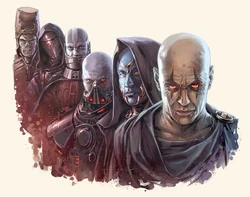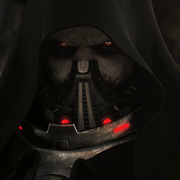| | |
- "The Darth title was more than just a symbol of power; it was a claim of supremacy. It was used by those Dark Lords who have sought to enforce their will on the other Masters. It was a challenge — a warning to bow down or be destroyed."
- ―Sith Blademaster, Kas'im
Darth was a title given to certain Sith Lords which preceded either their chosen Sith name, or, in some cases, their birth name.
Overview[]
- "As lethal as you must be to become a lord, a Darth is the embodiment of death. Don't forget that."
- ―Darth Baras to his back-cheeking apprentice

Six famous Sith Lords bearing the Darth title, from left to right: Darth Andeddu, Darth Revan, Darth Malak, Darth Malgus, Darth Ruin, Darth Bane.
Many Sith Lords chose to add "Darth" to their name, so much so that the word is considered synonymous with the dark side of the Force in some circles. It was also taken to signify giving up one's old life. Such examples are Anakin Skywalker becoming Darth Vader, or Jacen Solo becoming Darth Caedus. But the origins of the word are uncertain. It is often thought that "Darth" is merely a contraction of the title "Dark Lord of the Sith," but there are theories that suggest a deeper interpretation.
Origins[]
Some historians suggest that "Darth" is actually a corruption of the Rakata word Daritha, meaning "emperor". Others note another Rakatan connection: the words for "triumph" or "conquest" in Rakatan is darr, and the word for "death" is tah, leading to the theory that "Darth" is derived from darr tah and therefore means "triumph over death" or "immortal".[7] Given the Sith obsession with discovering the means to achieve immortality, this idea is not entirely without merit, at least on the surface. But others point out that the true meaning of darr tah is "conquest through death," meaning the conquest of one's enemies.[1]
Ultimately, the flaw in such theories involving a Rakatan origin is that, even if they are accurate, they cannot spring specifically from Revan or Malak's re-discovery of the Rakata and the Star Forge. Five years prior to their emergence as Sith Lords (3964 BBY), the title "Darth" was already well known by the Jedi in connection to the Sith, which is why Padawan Zayne Carrick could call Jarael "Darth Sunshine." In addition, Haazen claimed that if he were to take a name like the Sith of old, it would be "Darth Hayze," all but asserting that the title Darth was around prior to Revan and Malak's discovery.[8] There is still the possibility that one of the Rakatan theories could be correct, since the ancient Sith homeworld of Korriban had once been occupied by the Rakata (circa 28,000 BBY), which is one way either the Daritha or darr tah term could have entered the ancient Sith language. Darth Andeddu lived during the time of the old Sith Empire (6900 BBY to 5000 BBY), early enough for his holocron to come into the possession of the fallen Jedi Freedon Nadd.[9] He was known for experiments into eternal life, a possible link to the Rakatan term.
But even if the Rakatan connection proves to have some validity, numerous other cultures make similar claims to the etymology of the title, so for the present, there is no definitive answer as to what the term "Darth" truly means.
Usage[]
Ancient Sith[]
Amongst the Sith Lords who held the title of Darth long before the time of Darth Sidious' successful conquest of the galaxy was Darth Andeddu, a hoarder of Sith lore.[10] Naga Sadow, the last of the original Dark Lords of the Sith that ruled the old Sith Empire, held the title of Darth after ascending to the Sith throne just prior to waging the Great Hyperspace War.[11]
Revan and the Old Sith Wars[]

Darth Revan, the first to bear the mantle of Darth since the ancient Sith Lords
As part of the Old Sith Wars, the Jedi Revan and Malak betrayed the Republic after fighting in the Mandalorian Wars against the will of the Jedi Order, and the two descended to the dark side, styled themselves as Sith Lords, and took up the mantle of Darth. Malak betrayed Revan, his master, and took an apprentice of his own, dubbed Darth Bandon.[12] After the fall of Darth Revan and Malak, the strongest remnants of their empire gathered to form the elusive Sith Triumvirate, and the triumvirs each took up a Sith title containing the prefix Darth. The Lord of Betrayal styled herself as Darth Traya, whilst her apprentices, consumed by darkness, took up the names Darth Nihilus and Darth Sion. Traya was cast out by her pupils and came to be Kreia, the teacher of the Jedi Exile who led the true Jedi despite Sion and Nihilus' Jedi purge, which brought the Jedi Order's leader, Atris, to betray herself in her lust for power and made her the new Darth Traya. Nevertheless, the Sith Triumvirate was eliminated by the Jedi Exile, ridding the galaxy of the Sith.[13]
Vitiate's reconstituted Empire[]

Also holding the title of Darth, Malgus served the Sith Emperor, Darth Vitiate
However, the True Sith that descended from the efforts of Lord Vitiate, who came to power during the time of Naga Sadow, continued to grow outside of the Republic's borders. Vitiate took up the mantle of Darth and Sith Emperor,[14][15] and allowed high-ranking Sith Lords of his reformed Empire to take up the title of Darth. Amongst the numerous Darths of Vitiate's reconstituted Empire were members of the Dark Council, such as Vengean and Darth Vowrawn, as well as enforcers of the Emperor's will on the battlefield such as Darth Malgus.[source?]
The New Sith Wars and the Brotherhood of Darkness[]
- "Someone here once told me that the Darth title was no longer used because it promoted rivalry among the Sith. It gave the Jedi an easy target. It was easier just to abandon the custom. To have all the Sith Masters use the same title of Dark Lord. But I know the truth, Qordis. I know why none of you claim that name for yourself. Fear. You're cowards. None of the Brotherhood is worthy of the Darth title. Least of all you."
- ―Darth Bane
Later Sith Lords of the Jedi Civil War era also used the title Darth, as did the founding Sith Lord of the Light and Darkness War, Darth Ruin, though there were few later Sith bearing the title until the rise of Darth Rivan and Darth Bane.[1] During the Draggulch Period, Lord Kaan discouraged the usage of the term within the Brotherhood of Darkness, claiming that it promoted rivalry among the Sith. With the Sith of late suffering from constant infighting, Darth Bane believed that the concept of multiple Sith Lords diluted Sith power, and thought that the reason for prohibiting the use of the Darth title as merely the result of their fear of usurpation. Bane thus revived the use of the title for himself during the last days of the Brotherhood.[16]
The Rule of Two[]

Darth Sidious, who conquered the galaxy by becoming a duly elected Chancellor and successfully enacting the Grand Plan of the Sith Lords.
Darth Bane, as the only survivor of the Sith Order after the Seventh Battle of Ruusan, was largely able to reshape the Sith in his own image, instituting such reforms as the Sith of his lineage adopted the Darth title as he did, generally coupling it with a new Sith name (e.g. Sidious, Tyranus, Vader), which was chosen for the apprentice by the master at the time the apprentice swore allegiance to the Sith.[17][3] Not all usages of the term "Darth" during this time, however, preceded a Sith name, as Darth Maul's name had the title of "Darth" preceding his birth name.[18]
The One Sith[]
By the time of the One Sith, the "Darth" title was reserved only for those who proved their power and their unquestioning loyalty to Darth Krayt. Others, such as Vul Isen, were not entitled to the Darth title despite their expertise in the dark side of the Force, and weren't regarded as "real" Sith by some of the Darths.[4]
Behind the scenes[]
The title "Darth" first appeared in George Lucas' 1977 film, Star Wars: Episode IV A New Hope, as part of the name Darth Vader. Lucas intended the name "Darth Vader" to suggest "dark father."[19]
Darth is often thought to be a combination of letters from the title Dark Lord of the Sith, a theory which is alluded to in Jedi vs. Sith: The Essential Guide to the Force. Darth may also be a portmanteau of dark and death. Author and Star Wars: Knights of the Old Republic lead writer Drew Karpyshyn hinted at a booksigning in Huntington Beach, California, that he likes to think the Darth title was around before the Infinite Empire.
Prior to the release of The Phantom Menace, the only known Sith Lord to bear the title Darth was Darth Vader. When Darth Sidious and Darth Maul were revealed in The Phantom Menace, the title took on its distinct association with the Sith, and it has appeared throughout all eras of the Star Wars saga. As a result of the popularity of Star Wars, the term "Darth" has entered the popular lexicon as a term for evil. Most references are still associated with the Star Wars universe.
In A New Hope, Obi-Wan Kenobi addresses Darth Vader simply as Darth, which is the only instance in the films where the word is used isolated. It is possible that at this point in the development of the saga "Darth" was intended to be the character's name, not a title; in-universe, possibly Obi-Wan was deliberately emphasizing the title as a way of taunting Vader and driving home what he had become.
Appearances[]
Sources[]
Notes and references[]
- ↑ 1.0 1.1 1.2 1.3 Jedi vs. Sith: The Essential Guide to the Force
- ↑ 2.0 2.1 Legacy of the Force: Invincible
- ↑ 3.0 3.1 Dark Lord: The Rise of Darth Vader
- ↑ 4.0 4.1 Legacy (2006) 33
- ↑ 5.0 5.1 Darth Bane: Path of Destruction
- ↑ Star Wars: The Old Republic
- ↑ Darth Bane: Rule of Two
- ↑ Knights of the Old Republic 34
- ↑ The Complete Star Wars Encyclopedia
- ↑ Darth Bane: Dynasty of Evil
- ↑ The Essential Guide to Warfare
- ↑ Star Wars: Knights of the Old Republic
- ↑ Star Wars: Knights of the Old Republic II: The Sith Lords
- ↑ Star Wars: Force and Destiny Core Rulebook
- ↑ Star Wars: The Old Republic Encyclopedia
- ↑ Book of Sith: Secrets from the Dark Side
- ↑ Star Wars: Episode III Revenge of the Sith novelization
- ↑ Darth Plagueis
- ↑ Star Wars: Behind the Magic

